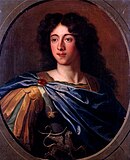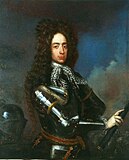Free election, 1697

|
|||||||||||||||||||
|---|---|---|---|---|---|---|---|---|---|---|---|---|---|---|---|---|---|---|---|
|
|||||||||||||||||||
|
|||||||||||||||||||
|
|||||||||||||||||||
Augustus II (Friedrich August)
(not the most voted)
On June 17, 1696, King John III Sobieski died in his palace at Wilanów near Warsaw. This meant that another free election was necessary, as the Polish-Lithuanian Commonwealth was left without a monarch.
One of the candidates for the Polish throne was the Duke of Oława (Lower Silesia) and son of the late king, James Louis Sobieski. He was initially supported by the Kingdom of France and the Swedish Empire. Also, among his followers were szlachta from Greater Poland, Lesser Poland, and Bishop of Kujawy, Stanisław Dąmbski. James Louis Sobieski, however, did not get along with his French-born mother, Marie Casimire Louise de La Grange d'Arquien. The mother and her son argued about properties of John III Sobieski, and as a result, James Louis lost the support of Polish nobility.
Another candidate, the Elector of Saxony Augustus II the Strong, was backed by influential and powerful Emperor Leopold I. To win the support of Roman Catholic, conservative Poles, Augustus decided to convert from Lutheranism to Catholicism. The conversion took place in Vienna, on June 2, 1697, and this decision won for Frederick the support of Pope Innocent XII.
...
Wikipedia





